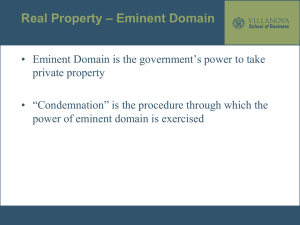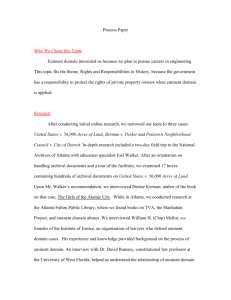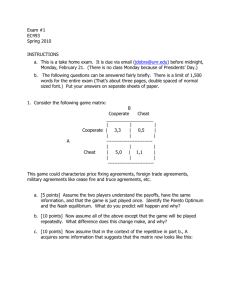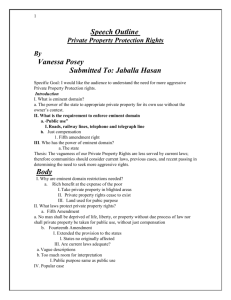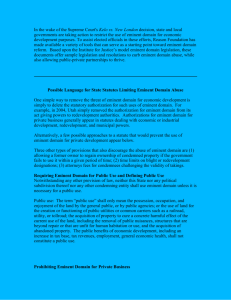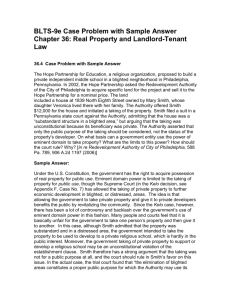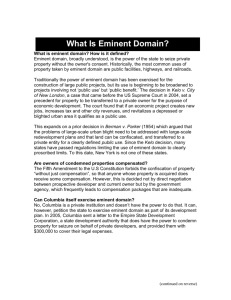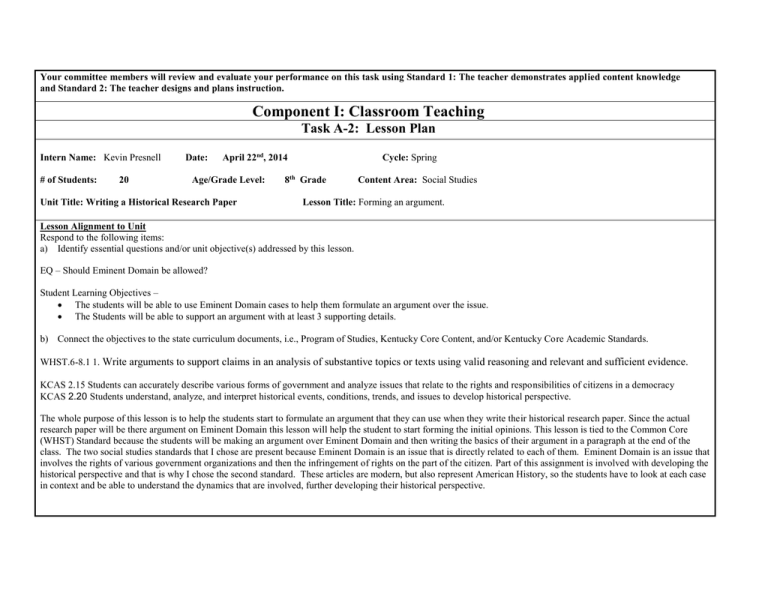
Your committee members will review and evaluate your performance on this task using Standard 1: The teacher demonstrates applied content knowledge
and Standard 2: The teacher designs and plans instruction.
Component I: Classroom Teaching
Task A-2: Lesson Plan
Intern Name: Kevin Presnell
# of Students:
20
Date:
April 22nd, 2014
Age/Grade Level:
Unit Title: Writing a Historical Research Paper
Cycle: Spring
8th Grade
Content Area: Social Studies
Lesson Title: Forming an argument.
Lesson Alignment to Unit
Respond to the following items:
a) Identify essential questions and/or unit objective(s) addressed by this lesson.
EQ – Should Eminent Domain be allowed?
Student Learning Objectives –
The students will be able to use Eminent Domain cases to help them formulate an argument over the issue.
The Students will be able to support an argument with at least 3 supporting details.
b) Connect the objectives to the state curriculum documents, i.e., Program of Studies, Kentucky Core Content, and/or Kentucky Core Academic Standards.
WHST.6-8.1 1. Write arguments to support claims in an analysis of substantive topics or texts using valid reasoning and relevant and sufficient evidence.
KCAS 2.15 Students can accurately describe various forms of government and analyze issues that relate to the rights and responsibilities of citizens in a democracy
KCAS 2.20 Students understand, analyze, and interpret historical events, conditions, trends, and issues to develop historical perspective.
The whole purpose of this lesson is to help the students start to formulate an argument that they can use when they write their historical research paper. Since the actual
research paper will be there argument on Eminent Domain this lesson will help the student to start forming the initial opinions. This lesson is tied to the Common Core
(WHST) Standard because the students will be making an argument over Eminent Domain and then writing the basics of their argument in a paragraph at the end of the
class. The two social studies standards that I chose are present because Eminent Domain is an issue that is directly related to each of them. Eminent Domain is an issue that
involves the rights of various government organizations and then the infringement of rights on the part of the citizen. Part of this assignment is involved with developing the
historical perspective and that is why I chose the second standard. These articles are modern, but also represent American History, so the students have to look at each case
in context and be able to understand the dynamics that are involved, further developing their historical perspective.
c)
Describe students’ prior knowledge or focus of the previous learning.
Prior to this lesson the students would have dealt with and found appropriate sources. This is crucial to understanding the bias in some sources as they look through
various articles. Also, the students would understand how to research material and find information from sources. The students would also have background
knowledge in understanding historical perspective and being able to look at the context and viewpoints in each article.
d) Describe summative assessment(s) for this particular unit and how lessons in this unit contribute to the summative assessment.
The summative assessment for this unit will be handled through a culminating project. The student will develop an argumentative essay that takes a stance on the issue
of Eminent Domain and then they must support their claims with a variety of sources. Since forming an argument is so essential to the overall process of writing the
paper, this lesson will be crucial for allowing the students to develop their first opinions of eminent domain. Also, the students will develop a presentation that defends
their arguments. They will be responsible for understanding their argument, and then the ability to answer questions that I will pose to get them to further elaborate
their stances.
e)
Describe the characteristics of your students identified in Task A-1 who will require differentiated instruction to meet their diverse needs impacting instructional
planning in this lesson of the unit.
There are 4 students in this class who need to receive differentiated instruction. These students have ADHD disabilities where they lack focus and are a bit active;
however, they tend to work in groups very well. For these students I will write a schedule on the Board that allows them to know what is being done in each segment
(also great for the rest of the class) and I will group them in mixed ability groupings as to allow each group a wide variety of abilities. This allows for students to help,
and build off of each other to make for a successful experience. Generally, the majority of this lesson is designed through Universal Design for Learning; so much of
my lesson does not have to be adapted because it was designed to include all of these elements.
f)
Pre-Assessment: Describe your analysis of pre-assessment data used in developing lesson objectives/learning targets (Describe how you will trigger prior
Knowledge):
Since their argumentative papers are going to be over the concepts of eminent domain, I plan to do a visual discovery lecture over a political cartoon that is describing. In
this activity I will have them analyze a political cartoon over eminent domain so I can get them started thinking about eminent domain as a topic. Also, I plan to pass out
candy at the beginning of class, and then after the Preview Assignment I plan to tell the students that it is in their best interest that I take the candy back. Tell them since I
am the government and I determined what the best interest is I can just take back anything I want. But, I will fairly compensate them by allowing anyone to get a drink of
water if they want one.
Lesson Objectives/
Learning Targets
Assessment
Instructional Strategy/Activity
Strategy/Activity:
Comparison Matrix allows the students to learn about certain cases of
eminent domain. Then, the hamburger paragraph outline forces the
students to take a stance and make an argument for or against
Objective/target:
The students will be able to formulate an
argument over Eminent Domain cases.
Assessment description:
Comparison Matrix that starts the initial opinion
on the subject of Eminent Domain
Exit slip paragraph that forces student to make an
argument for or against eminent domain.
Assessment Accommodations:
Assessments are also available in online versions.
Activity Adaptations:
Certain readings will be at different levels
Mixed Ability groupings to allow support in each group
Printed versions of the articles
Media/technologies/resources:
Projector and PowerPoint
YouTube video
IPad
Polleverywhere.com
Cellphones
Weebly.com
Strategy/Activity:
Comparison Matrix allows the students to learn about certain cases of
eminent domain. Then, the hamburger paragraph outline forces the
students to take a stance and make an argument for or against
Objective/target:
The Students will be able to support an
argument with at least 3 supporting details.
Assessment description:
Hamburger paragraph that forces the students to
provide three supporting details to
Assessment Accommodations:
Assessments are also available in online versions
Activity Adaptations:
Hamburger Paragraph simplicity which I will use as a Universal design
for learning to allow all students this basic step
Electronic and printed versions of the document
Media/technologies/resources:
iPad
Projector
Procedures: Describe the sequence of strategies and activities you will use to engage students and accomplish your objectives. Within this sequence, describe how the
differentiated strategies will meet individual student needs and diverse learners in your plan. (Use this section to outline the who, what, when, and where of the instructional
strategies and activities.)
1) Meet Students at the door, welcoming them into the class with a smiling face and a piece of candy instructing them not to eat until instructed.
2) Have students get iPads and go to the site: mrpresnell.weebly.com (2 Minutes)
3) Place the Political cartoon on the overhead and pass out the image analysis preview activity sheet (attached: Image Analysis). Give around 5 minutes to complete.
If the students need a better look at the image it is also on the Weebly.(5 Minutes)
4) Once the 5 minutes is up, tell students that we are about to go over the activity and then start analyzing the photo with them. Ask leading questions while
responding to their answers, such as: What do you think this picture represents? What could involve local government destroying houses? How do you feel about
this image? (5 Minutes)
5) Now refer to the candy that was passed out earlier, tell the students that a college professor once told me that giving students candy as an incentive was bad form
since it promoted childhood obesity. Ask the students to return the candy to the bags since it is in the best interest of the class. Now have students take the poll
everywhere poll, by either texting their results or clicking the button on the weebly. Discuss the results with the class (2 Minutes)
6) Show the video on the projector (not on individual iPads because it would be to many individual videos running at once): http://youtu.be/dwIUrUYni9o to provide
more context on the issue (1 Minute)
7) Let students read article (attached Supreme Court backs municipal land grabs) by following directions online. This article shows the historical perspective of how
modern Eminent Domain was reinforced. (10 Minutes)
8) Discuss Eminent Domain by having students define. Questions: What is Eminent Domain? How do you think it works? What do you think the best public interest
is? Who do you think defines it (the best public interest)? What do you think fair market value is? Who do you think defines it? (5 Minutes)
9) Briefly discuss what it means to form an argument. What is an argument? Is an argument fact or opinion? What is a fact versus Opinion? What is a supporting
detail? Why are having supporting details important? (5 Minutes)
10) Tell the instructions for the activity. Students will be in groups of 4 where each student will be assigned an article that they are supposed to read and complete the
corresponding section on the comparison matrix. After all members have read and completed their section they are supposed to share with the rest of their
members what they found in their article. After all members have shared their articles, each student will complete a hamburger paragraph form that states an
opinion on Eminent domain, gives three supporting details, and has a conclusion. The articles are all posted on the weebly that takes the students to the direct link
of the actual company that posted the activity (2 Minutes) (attached Eminent Domain Comparison, Hamburger Paragraph ans Articles A-D).
11) Have students get into the groups that have already been assigned according to their mixed abilities and complete the activity. (20 Minutes)
12) Review what we have done in the class period: Learned about eminent domain, formed an opinion about eminent domain, formed and argument over eminent
domain, and supported it with 3 details
13) Exit Slip: Take the Hamburger Paragraph that was created and write it into a smooth paragraph that explains their stance. This should be completed on the Weebly
or on a separate sheet of paper. (5 Minutes)
Image Analysis
Circle the type of image: Photograph
I.
Cartoon
Table/Graph
Other:___________
Gathering Evidence:
a. What words are present in the image?
b. What do you see that looks different than it would in a photograph?
II. Interpreting Evidence
a. What issue do you think this image is about?
b. Who do you think is the audience for this image?
III. Forming Hypothesis
a. What do you think the creator’s opinion is on this issue?
b. What methods does the creator use to persuade the audience?
Eminent Domain Comparison
While Reading (Paper Version):
Underline or Highlight and sentence you think is opinionated
Circle any word you do not know
*Asterisk* any phrase you think is a supporting detail.
Online Version you should follow the directions attached
Article A
What is the title?
Did you find an
opinion in this
article? If so,
what side did it
take?
Where is the
Eminent Domain
case?
What is the side
of the
government in
this case?
What is the other
side in this case?
How has this
article affected
your opinion of
Eminent
Domain?
Article B
Article C
Article D
Now Take a Stance!
Directions: Now that you know a little about Eminent Domain and some
applications of this policy in real life, outline a paragraph that forms your stance on
Eminent Domain. You should: 1) Have a topic that states your opinion 2) 3
supporting reasons why you have taken this stance 3) a conclusion sentence
summing up your stance.
Supreme Court backs municipal land
grabs
Justices affirm property seizures for private development
By Bill Mears
CNN Washington Bureau
WASHINGTON (CNN) -- In a victory for cities, a divided Supreme Court
concluded Thursday that local governments have the authority to
seize private land and turn the property over to private developers for
economic development.
Government's authority to condemn land for public use traditionally has been used to eliminate slums or
build highways, schools and other public works.
But Tuesday's 5-4 ruling found that local officials can use their "eminent domain" power to condemn
homes in a working-class neighborhood for private development in hopes of boosting tax revenue and
improving the local economy.
Connecticut case
The case pitted the city of New London, Connecticut, against homeowner Susette Kelo and six other
families who were trying to keep the municipality from condemning their homes for use as part of a
redevelopment project, centered around a $270 million global research facility built by the pharmaceutical
giant Pfizer.
Kelo and her neighbors filed suit, arguing their property rights were being violated by well-connected
developers. But the Supreme Court found the city could go forward with the project and condemn the
homes.
"Promoting economic development is a traditional and long-accepted function of government," Justice
John Paul Stevens wrote for the majority.
O'Connor: Court overstepped
But writing for the dissenters, Justice Sandra Day O'Connor wrote that the court overstepped its authority.
"The court today significantly expands the meaning of public use," O'Connor wrote. "It holds that the
sovereign may take private property currently put to ordinary private use, and give it over for new,
ordinary private use."
Scott Bullock, the homeowners' lawyer, said, "Every home, church or corner store" would be vulnerable to
being replaced by commercial development under the ruling, "since they produce more tax revenue." He
said a very high standard should be used when applying eminent domain since "every city has problems
and wants more tax revenues."
Stevens concluded that the city's plan "unquestionably serves a public purpose" and the majority
appeared to defer to the judgment of local officials over the courts to navigate that standard.
"The city has carefully formulated an economic development plan that it believes will provide appreciable
benefits to the community, including -- but by no means limited to -- new jobs and increased tax revenue,"
he wrote.
Cities hail the decision
The National League of Cities hailed the decision, saying it would allow cities to keep "one of their most
effective tools for ensuring economic development."
"Eminent domain is not a power to be used lightly," Washington, D.C. Mayor Anthony Williams, the
group's president, said in a written statement. "We must be sensitive to those who may be displaced.
However, as part of a legislative process, with citizen input and discussion, it is one of the most powerful
tools city officials have to rejuvenate their neighborhoods."
The case stems from New London's 2000 plan to redevelop 90 acres of the Fort Trumball neighborhood.
The city council transferred eminent domain power to the New London Development Corporation, a
private, non-profit group of citizens, business owners and community leaders.
The company wants to build a conference center, hotel complex, offices, condominiums and, eventually,
an aquarium in New London, located about 125 miles east of New York.
Residents were ordered out of their homes in 2000, but several rejected the city's compensation package
and fought the move in court.
"There's no amount of money that can compensate for what the other side of that coin would be," said
Matt Dery, who said his family has lived in Fort Trumball for a century. "Truly, my parents don't want to
wake up rich ... they just want to wake up tomorrow where they live."
'Blow to homeowners'
The libertarian Cato Institute, which filed a friend-of-the-court brief on Kelo's behalf, called the decision a
"blow to homeowners and small business people."
"With today's decision, no one's property is safe, since any time a government official thinks someone
else can make better use of your property than you're doing, he can order it condemned and transferred,"
Roger Pilon, the group's director of constitutional studies, said in a written statement.
Wesley Horton, an attorney for New London, said the city understands the situation the homeowners
face, "but you have to remember that can happen if there was a road going in, or a school. It doesn't
make any difference what type of condemnation there is.
"Obviously that's a sad situation, there's no question about it," he said. "But you can't have one rule for
roads and another rule for blight and a third rule for economic development. It's all the same thing."
Joining Stevens in the majority were justices Stephen Breyer, Ruth Bader Ginsburg, David Souter and
Anthony Kennedy. Chief Justice William Rehnquist, and justices Antonin Scalia and Clarence Thomas
joined O'Connor's dissent.In a concurring opinion, Thomas predicted the ruling would cause long-term
problems.The consequence of today's decision are not difficult to predict, and promise to be harmful," he
wrote. "So-called 'urban renewal' programs provide some compensation for the properties they take, but
no compensation is possible for the subjective value of these lands to the individuals displaced and the
indignity inflicted by uprooting them from their homes."
The case is Kelo v. City of New London (04-0108).
ARTICLE A
Saving New Jersey’s Coast
New York Times – January 2nd, 2014
http://nyti.ms/1hvtQHf
Hurricane Sandy made a direct hit on New Jersey just over a year ago,
killing 34 people and devastating much of the state’s Atlantic coast. Now,
communities that want to build sand dunes to provide protection when (not if)
another storm hits are being thwarted by landowners who have refused to allow the
dunes to be built on their property. Areas with dunes fared better in the storm than
those without them.
As of last week, the state needed 2,889 property owners along the coast to
agree to easements for the dunes. About one-fourth, more than 700, were holding
out, many of them concerned about losing their views.
Because their resistance is likely to make conditions less safe for everyone,
the state and some local communities are threatening to seize parts of their
property — essentially part of their front yards — by eminent domain and build the
dunes anyway; public safety is a legitimate reason to exercise eminent domain. It is
unfair for a few to jeopardize the lives and property of so many others.
Gov. Chris Christie, once skeptical about using eminent domain to
commandeer private property, changed his mind in this case, a spokesman
explained last week. And once he made that decision, he put the full force of his
office behind it. “We are building these dunes, O.K.?” Mr. Christie said at a
meeting of homeowners last spring. “We are building these dunes whether you
consent or not.”
There might have been more diplomatic ways to put it, but the governor was
right. In September, he signed an executive order requiring the attorney general to
“immediately coordinate legal action” to acquire the necessary easements. It’s past
time for the holdouts to do their part to protect lives and property, including their
own.
ARTICLE B
Eminent domain could be used to build Falcons stadium
http://www.wsbtv.com/news/news/local/eminent-domain-could-be-used-build-stadium/nZ7bX/
ATLANTA, Ga. — Eminent domain could be used after all to the build the
Falcons billion-dollar stadium.
Even though the churches have agreed to a deal, there are still six
other properties that need to be acquired for the stadium to be built on the
south site.
The majority of the six properties are under or near the Martin
Luther King Jr. Boulevard overpass. They are mostly parking areas and
have been overlooked due to the agreements with the two Baptist
churches.
The properties are less than 2 acres combined. One of them
has a billboard on the land.
Eminent domain allows the state to seize
private property without the owner's consent.
When Channel 2's Craig
Lucie asked the city of Atlanta about the six properties, they referred us to
the Georgia World Congress Center Authority.
Lucie asked the GWCC
to get the exact locations for the six properties and who they belong to.
Their spokeswoman, Jen LeMaster, sent an email stating, "As these are
active property negotiations, we cannot discuss any details."
Channel 2
Action News knows who the owner is for at least one of the properties, but
we were not able to reach him Wednesday.
The owner has revealed in
the past though that he will turn over the land.
Mayor Kasim Reed recently said negotiations went well with the
churches.
"We never used the eminent domain tactic or threat and we came to
what, by all opinions that I'm aware of, is a fair arrangement, so I feel
terrific," Reed said.
Reed made that statement after sealing a deal with
Friendship Baptist Church and Mt. Vernon Baptist Church worth $34 million
combined.
Lucie asked the GWCC if they will have to exercise eminent
domain.
"No, we have not ruled that out. We hope we can reach a fair
market value deal, but if we can't, condemnation is a possibility," LeMaster
wrote in her email.
Oct. 1 is the deadline for the Falcons to say that they
have chosen the south site as their stadium location. Channel 2 Action
News will be watching to see what deals are struck to acquire the land near
MLK Boulevard.
-Article C-
Eminent domain emerges as front in Bluegrass
Pipeline battle
http://www.wdrb.com/story/24296340/eminent-domain-emerges-as-new-front-in-bluegrass-pipeline-battle
LOUISVILLE, Ky. (WDRB) – The battle over whether the Bluegrass Pipeline is built in Kentucky may
hinge on a legal, not an environmental, question: Can the project's developers condemn land if they can't
come to terms with property owners?
Pipeline officials say Kentucky law clearly gives them the power of eminent domain, but opponents
disagree. For its part, a review by the state Energy and Environment Cabinet concluded that the project
can't use condemnation.
A lawsuit filed earlier this month in Franklin Circuit Court is asking a judge to rule whether the Bluegrass
Pipeline qualifies for condemnation in acquiring the easements needed for the project, which would carry
as many as 400,000 barrels a day of natural gas liquids through 13 Kentucky counties along a mostly
underground route from Pennsylvania to the Gulf of Mexico.
Kentuckians United to Restrain Eminent Domain filed the lawsuit on a behalf of Penny Greathouse, a
Franklin County land owner who alleges in court documents that she was told by a pipeline representative
that developers have the right to condemn land. The project has requested an easement on her farm, she
said in an affidavit filed in the case.
"Whether that power exists has a significant bearing on whether I will agree to negotiate an easement
with Bluegrass Pipeline, and the terms of that negotiation," she said.
Kentucky law allows condemnation when land is taken for a "public use" -- ownership by state or other
government entities, as well as by public utilities or "common carriers" that transport oil or natural gas.
Roads, railroads and dams are examples of projects for which state law permits eminent domain.
Even when property is condemned, landowners receive payments based on the value of the property.
The pipeline's developers believe they have the ability to condemn land. In a letter filed in the lawsuit,
pipeline executive Wendell Hunt told Franklin County Judge-Executive Ted Collins that three specific
state statutes allow eminent domain.
Those include sections of state law that:
Allow condemnation by companies that are "engaged in or
proposing to engage in, constructing, maintaining, or operating oil
or gas wells or pipelines for transporting or delivering oil or gas,
including oil or gas products, in public service."
Include "common carriers" among the entities that use property
for a "public use."
Consider every company "receiving, transporting or delivering a
supply of oil or natural gas for public consumption" to be a
common carrier.
Pipeline opponents have argued that the project doesn't qualify as a public service because it would
transport natural gas liquids -- hydrocarbons separated from natural gas during hydraulic fracturing, or
"fracking" operations – between private companies.
But would the pipeline operator qualify as a "common carrier" – a linchpin of the argument made to
Franklin County Circuit Court?
"Bluegrass Pipeline meets the criteria of a common carrier under Kentucky law because it will provide
open access to any potential customer that is willing to meet the Bluegrass Pipeline's tariff conditions and
pay the tariff rate," Hunt, the pipeline agent, wrote in his August 1 letter.
Under Kentucky law, common carriers ship oil or natural gas – the law is silent on natural gas liquids – for
public consumption.
A previous court ruling on common carriers was part of a July staff opinion by Kentucky Public Service
Commission executive director Jeff Derouen in response to a letter from Tom FitzGerald, director of the
Kentucky Resources Council. (FitzGerald, a Louisville attorney, is representing the plaintiffs in the
Franklin Circuit lawsuit.)
Derouen's opinion noted a bankruptcy court's decision in a 1982 case involving a natural gas producer,
who had attempted to get a common carrier to carry his gas. The court found that Kentucky law "applies
only to companies engaged in the transportation of gas ‘for public consumption' – that is, for ultimate use
by Kentucky consumers," according to an excerpt of the decision Derouen cited.
Meanwhile, Kentucky lawmakers have pre-filed bills for the 2014 General Assembly that would require
additional steps before the pipeline developers could seize easements from reluctant property owners.
The proposed legislation includes, for example, making oil and gas pipeline projects eligible for
condemnation only if they're regulated by the Public Service Commission.
But Jim Waters, president of the Bluegrass Institute, a libertarian-leaning think tank, said the proposed
changes to condemnation law are "unnecessary" and "overkill." The General Assembly already has
strengthened the law, giving more protections to private property owners, in the wake of a 2005 U.S.
Supreme Court ruling that allowed private developers to seize private property, Waters said.
"There are much more important and immediate issues that need to be addressed," said Waters, who
accused legislators pushing the condemnation laws of trying to get "political mileage."
The joint venture pursuing the pipeline -- Boardwalk Pipeline Partners L.P. and the Williams Cos. – had
acquired more than 50 percent of the easements needed for the project's right of way in Kentucky as of
Dec. 5. A Williams spokesman has said the company doesn't comment on pending lawsuits.
In an interview with WDRB in November, Williams director of corporate development Bill Lawson said
eminent domain is the "course of last resort."
"It's our best interest to work with landowners and to find those that are interested in having us cross their
property," Lawson said.
The pipeline debate has been particularly bitter in Kentucky, where opponents have questioned the
safety records of the developers and the wisdom of routing a hazardous materials pipeline through the
region's karst geology.
In turn, pipeline officials have touted the project's creation of temporary construction and long-term
monitoring jobs in Kentucky, and they claim the pipeline will help the nation help achieve energy
independence.
Williams' plans call for construction to begin in 2014.
In an interview, Greathouse said pipeline agents have made four or five proposals for part of her Franklin
County farm since last April. The offers, which started around $200,000, have climbed to more than
$600,000, she said.
Greathouse said a declaratory judgment by the court is important "for everyone who is involved, so they
don't feel pressured to take the first offer."
Copyright 2013 WDRB News. All rights reserved.
Article D
Families Losing Homes for Bike Trail
National Review
http://www.nationalreview.com/article/371603/families-losinghomes-bike-trail-andrew-johnson
A handful of Minnesota landowners could soon see their treasured riverfront
property along the Mississippi River turn into a bike trail under eminent domain.
For one man, this would mean losing land that has been in his family since 1896.
Dakota County is resorting to land seizures to build the Mississippi River Regional
Trail in an effort to qualify for millions in federal land grants. The county must
start be ready to start construction on the project by March 31 or else risk losing
the funds. While most of the desired 127 acres for the project have already been
acquired through purchases and negotiations, the few remaining holdouts are suing
the county after officials sought “quick-take condemnation” of their property.
Advertisement
Sisters Nancy Drews and Joni Sargent, whose father wanted to pass the land along
the river to his grandchildren before he passed away in November, are taking
Dakota County to court after it reneged on previous negotiations. After numerous
“good faith” meetings with the county, Drews and Sargent told the Hastings Star
Gazette that they were in talks about an offer for one to two acres of their 10-acre
property.
But in November, the same month their father died, the county commission voted
to take the whole parcel. “The board has come to the conclusion that it is time to
move forward,” one member said after the vote. “We’re just coming to the head
now. It’s time to move forward.” In their vote, the county commission also seized
the other remaining properties.
Drews, Sargent, and their neighbors argue the county didn’t have to take all the
property for the project, which would also include a picnic area and dock along the
river. A Dakota County lawyer countered that under Minnesota state law the
county doesn’t have to prove the condemnation is “absolutely necessary,” but
instead just “reasonably necessary or convenient for the furtherance of a proper
purpose,” according to the St. Paul Pioneer Press.
On top of all that, the landowners say they’re not getting a fair price for their
property. The county commission voted to pay a total of $2 million for the four
remaining properties; Drews and Sargent contend that their father could have sold
just his own land for $1.3 million a few years ago.
Wednesday afternoon marked the first day of the hearing in court, where backers
of the landowners gathered outside the courthouse in support, even if some believe
it is already a lost fight. “It’s a real sad thing,” Gunter Drews, Nancy’s husband,
said. “History is going the way of the bulldozer again.”
The sisters said they will continue to do everything in their power to hold on to the
land they grew up on. “It just means way too much to us,” Drews said. “We can’t
lose it.”

